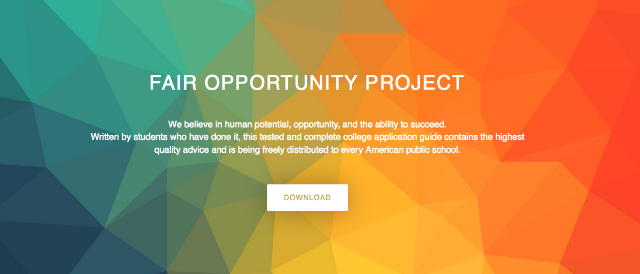News
Harvard John A. Paulson School of Engineering and Applied Sciences students Cole Scanlon, A.B. '18 (left), and Luke Heine, A.B. '17, co-direct the Fair Opportunity Project, a free, easily accessible college admissions guide. (Photo by Adam Zewe/SEAS Communications.)
Luke Heine, A.B. ’17, would never have considered applying to Harvard if not for a chance meeting with a friend at a McDonald’s in his northern Minnesota hometown. Heine thought Harvard would be out of reach because of tuition costs, but his friend explained that Ivy League universities offer first-rate financial aid.
But tuition was just one piece of the college application puzzle. Heine later learned about ACT study resources while working out in his high school weight room. He borrowed a study book from a fellow athlete and significantly boosted his score.
“I felt extremely lucky, growing up in a rural area, to serendipitously come into the information I needed to apply for college later,” said Heine, a sociology and computer science concentrator at the John A. Paulson School of Engineering and Applied Sciences. “There is this huge vacuum of information about applying to college in the rural Midwest.”
So he set out to help fill that void by creating a free, easily accessible college admissions guide.
The Fair Opportunity Project, launched this summer and born out of the smaller guide Heine developed on his own, incorporates information from 20 college students, more than 200 high school guidance counselors who have offered feedback, and 10 advisors who bring wide-ranging educational expertise, including Richard Barth, CEO of KIPP Schools, Michael Brown, CEO and co-founder of City Year, and Graduate School of Education Professor Katherine Merseth, founder of Harvard Teacher Fellows.
The project isn’t meant to supplant counselors; rather, it is designed to help school administrators provide another set of tools for students. The need is great, since U.S. public high schools employ about one counselor for every 500 students. The Huffington Post reported that more than a quarter of college applicants hired private admissions tutors in 2013, at a cost of $1,000 to $10,000 per tutor.
The Fair Opportunity Project seeks to level the playing field by providing resources and tips free-of-cost, Heine said. At the start of the school year, the team emailed the guide to every publicly listed guidance counselor, principal, and superintendent in the nation. The 67-page guide covers topics such as the application timeline and financial aid, and it even includes examples of successful college essays.
“Students really appreciate having these sample essays they can look at for examples,” said Jonah Hahn, A.B. ’17, a social studies concentrator. “College essay questions can be very daunting, especially if you don’t have someone you can ask about what they wrote. By presenting this information to the students directly, we create a level of authenticity because we volunteered our own college essays.”
Developing the guide continues to be an iterative process, and the team pushes out frequent updates based on feedback from counselors and students, explained Cole Scanlon, A.B. ’18, an applied math and economics concentrator and co-director of the project with Heine. Drawing on the best practices of software companies, which rely on agile methodologies, the students incorporated more than 50 updates into the guide over the past two months.
Maintaining a basic website and offering a simple PDF guide enables that nimbleness. The team wants to ensure the resource remains easily accessible, even as they make it more robust. They plan to soon translate the guide into Spanish, and then possibly other languages. The team is also pursuing the development of supplemental or additional guides focused on subsets of students, such as international students or undocumented students.
“This has become a truly collaborative project, where everyone is providing input and expertise, with all efforts toward making this the best resource for students,” said Scanlon. “We’ve received hundreds of emails from students, counselors, administrators, and parents who have told us about how they are using the guide. We feel a lot of fulfillment and a very tangible social impact.”
The students are also considering how to incorporate more technological resources, such as a video blog series and the creation of a Massive Open Online Course (MOOC) format for the guide.
Novel ideas will drive the project forward, Heine said, but its core mission stems from a long tradition of student service at Harvard.
“We are in one of the most fortunate places in the world, and I think everyone on our team really believes that, to whom much is given, much is required,” he said. “Having these tools and skills, and the ability to make a difference, how could we not do this?”

Cutting-edge science delivered direct to your inbox.
Join the Harvard SEAS mailing list.
Press Contact
Adam Zewe | 617-496-5878 | azewe@seas.harvard.edu
